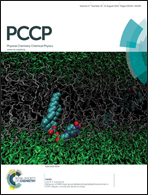Light-induced water splitting by titanium-tetrahydroxide: a computational study†
Abstract
Water oxidation by Ti(OH)4 in the ground and excited states was investigated using density functional (ΔSCF, TDDFT) methods gauged by the coupled cluster (CCSD, CCSD(T)) calculations. O2 and H2 are generated in a reaction sequence that starts with Ti(OH)4 reacting with H2O. This reaction can proceed by either nucleophilic attack by H2O or by H-atom abstraction from H2O. The nucleophilic attack has high energy barriers (40–120 kcal mol−1) in both the ground and excited states. On the other hand, H abstraction is effected by Ti(OH)4 in the excited state with a low energy barrier (4–8 kcal mol−1), generating OH˙. This is the rate-limiting barrier in the chain of O2 formation reactions proposed in this work. The production of free OH˙ radicals is not energetically feasible in the ground state. By absorbing two photons, two hydroxyl radicals are produced, which then form H2O2. By a stepwise H-abstraction from H2O2 and OOH˙, O2 is generated by absorbing two more photons. In each H-abstraction reaction a Ti(OH)4 is consumed and a Ti(OH)3H2O is produced. H2 production can proceed thermally from the latter in a very exothermic (68–105 kcal mol−1) bimolecular reaction. The solvent effects, modelled by explicit water molecules, have a limited influence on the reactivity.


 Please wait while we load your content...
Please wait while we load your content...